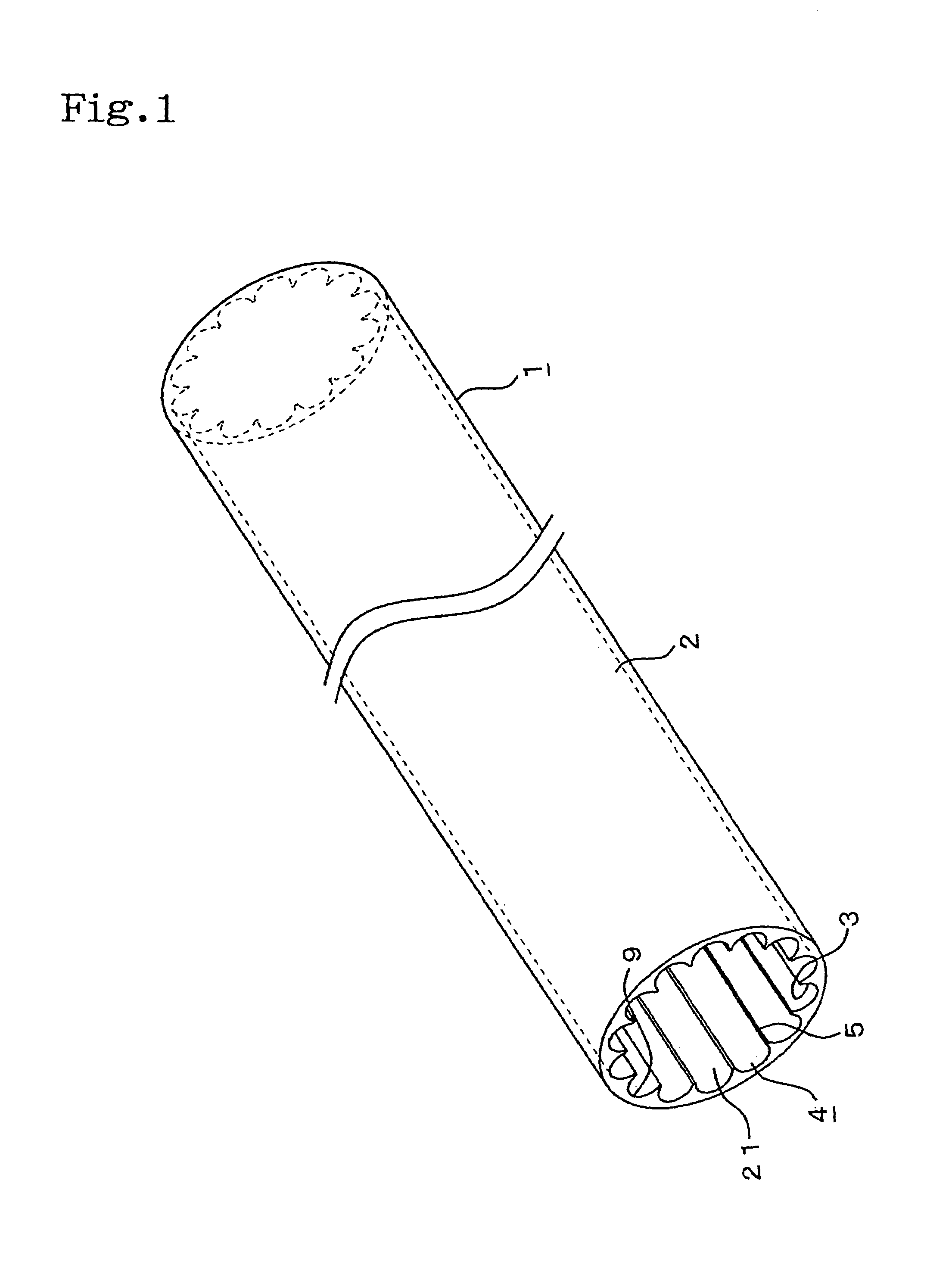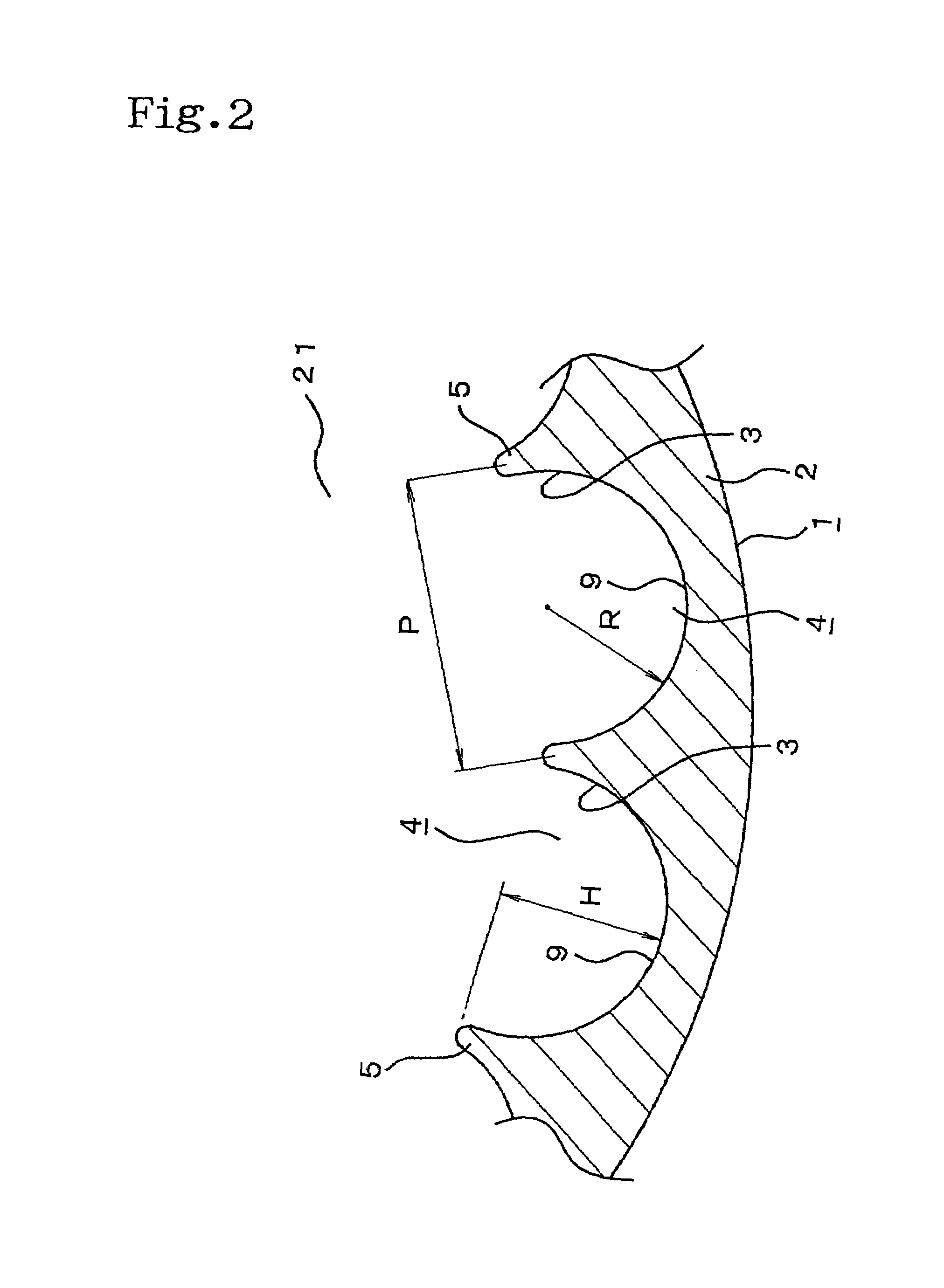Heat transfer pipe and heat exchange incorporating such heat transfer pipe
a technology of heat transfer pipe and heat exchanger, which is applied in the direction of indirect heat exchanger, light and heating apparatus, laminated elements, etc., can solve the problems of reducing the workability of heat conductor pipe, reducing the thermal conductivity of low-energy coatings such as fluoric resin, and reducing the thermal conduction efficiency. , to achieve the effect of not reducing the thermal conduction efficiency
- Summary
- Abstract
- Description
- Claims
- Application Information
AI Technical Summary
Benefits of technology
Problems solved by technology
Method used
Image
Examples
first embodiment
[0047]Hereinafter, according to a heat conductive pipe of this invention, the first embodiment in which the heat conductive pipe an EGR gas cooling apparatus is used in a cooled EGR system for automobiles is described in reference to FIG. 1, FIG. 2, and FIG. 3. Numeral 1 is the heat conductive pipe wherein axially extending grooves having a cross section perpendicular to a direction of the pipe axis defined recesses 3 in a shape with a prescribed depth on an inner circumferential surface of a base pipe 2.
[0048]The axially extending grooves 4 are formed parallel to a pipe axis in a row in a circumferential direction of the heat conductive pipe 1. The axially extending grooves 4 in a row form dividing walls 5 with a prescribed thickness dividing between themselves. According to the first embodiment, bottom portions 9 of the axially extending groove 4 and the dividing wall 5 are formed running in a circular shape, thereby forming a cross section of the recess 3 in a substantially semic...
second embodiment
[0057]Furthermore, in the second embodiment, as shown in FIG. 4 and FIG. 5, the plurality of the axially extending grooves 4 having a cross section in a recess 3 shape perpendicular to the direction of the pipe axis with the prescribed depth are formed parallel to the pipe axis in a row not only on the inner circumferential surface of the base pipe 2 but also on each of the surfaces of the plate-shaped fin member 18. Furthermore, a dividing wall 5 having a prescribed thickness partitioning the axially extending grooves 4 adjacent to each other in a row is formed thereon.
[0058]As shown FIG. 2 and FIG. 5, in the axially extending grooves 4 formed on the inner circumferential surface of said base pipe 2 and on each of the surfaces of the plate-shaped fin member 18, distance P between the centers of the dividing walls 5 next to each other is defined from 0.2 to 2.0 mm, and distance H from the top of the dividing wall 5 is defined from 0.5 P to 1.0 P mm. Furthermore, radius R of the rece...
third embodiment
[0062]Also, in the third embodiment, though the plurality of the axially-extending grooves 4 having the cross section in the circularly recess 3 shape with the prescribed thickness are formed in a row on the inner circumferential surface, of the base pipe 2 and each of the surfaces of the plate-shaped fin member 18, the connecting surfaces 19 of the plate-shaped fin member 18 and the portions to be connected to the connecting surfaces 19 of the inner circumferential surface of the base pipe 2 are formed without forming the axially extending grooves 4, thereby enlarging the contacted area to allow the thermal conductivity between the base pipe 2 and the plate-shaped fin member 18 to be performed well.
[0063]However, the axially extending grooves 4 may be formed on the connecting surfaces 19 of the plate-shaped fin members 18 and on the inner circumferential surface of the base pipe 2 all over, thereby arising gaps between the connecting surfaces 19 and the inner circumferential surfac...
PUM
| Property | Measurement | Unit |
|---|---|---|
| depth | aaaaa | aaaaa |
| distance | aaaaa | aaaaa |
| distance | aaaaa | aaaaa |
Abstract
Description
Claims
Application Information
 Login to View More
Login to View More - R&D
- Intellectual Property
- Life Sciences
- Materials
- Tech Scout
- Unparalleled Data Quality
- Higher Quality Content
- 60% Fewer Hallucinations
Browse by: Latest US Patents, China's latest patents, Technical Efficacy Thesaurus, Application Domain, Technology Topic, Popular Technical Reports.
© 2025 PatSnap. All rights reserved.Legal|Privacy policy|Modern Slavery Act Transparency Statement|Sitemap|About US| Contact US: help@patsnap.com



